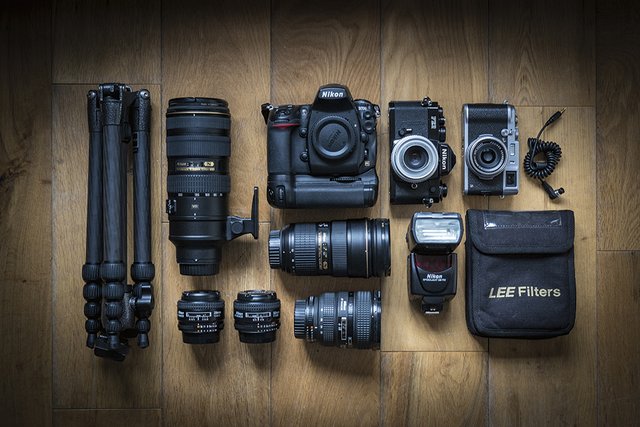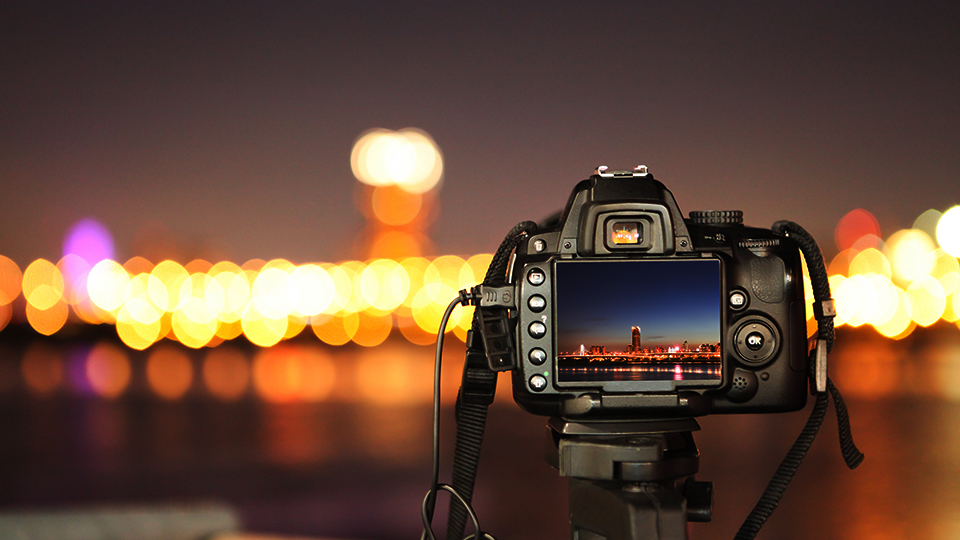Photography
Photography is the science, art, application and practice of creating durable images by recording light or other electromagnetic radiation, either electronically by means of an image sensor, or chemically by means of a light-sensitive material such as photographic film.
Typically, a lens is used to focus the light reflected or emitted from objects into a real image on the light-sensitive surface inside a camera during a timed exposure. With an electronic image sensor, this produces an electrical charge at each pixel, which is electronically processed and stored in a digital image file for subsequent display or processing. The result with photographic emulsion is an invisible latent image, which is later chemically "developed" into a visible image, either negative or positive depending on the purpose of the photographic material and the method of processing. A negative image on film is traditionally used to photographically create a positive image on a paper base, known as a print, either by using an enlarger or by contact printing.

Photography is employed in many fields of science, manufacturing (e.g., photolithography), and business, as well as its more direct uses for art, film and video production, recreational purposes, hobby, and mass communication.
An amateur photographer is one who practices photography as a hobby/passion and not necessarily for profit. The quality of some amateur work is comparable to that of many professionals and may be highly specialized or eclectic in choice of subjects. Amateur photography is often pre-eminent in photographic subjects which have little prospect of commercial use or reward. Amateur photography grew during the late 19th century due to the popularization of the hand-held camera.[39] Nowadays it has spread widely through social media and is carried out throughout different platforms and equipment, switching to the use of cell phone as a key tool for making photography more accessible to everyone.
Commercial photography is probably best defined as any photography for which the photographer is paid for images rather than works of art. In this light, money could be paid for the subject of the photograph or the photograph itself. Wholesale, retail, and professional uses of photography would fall under this definition. The commercial photographic world could include:
Advertising photography: photographs made to illustrate and usually sell a service or product. These images, such as packshots, are generally done with an advertising agency, design firm or with an in-house corporate design team.
Fashion and glamour photography usually incorporates models and is a form of advertising photography. Fashion photography, like the work featured in Harper's Bazaar, emphasizes clothes and other products; glamour emphasizes the model and body form. Glamour photography is popular in advertising and men's magazines. Models in glamour photography sometimes work nude.
Concert Photography focuses on capturing candid images of both the artist or band as well as the atmosphere (including the crowd). Many of these photographers work freelance and are contracted through an artist or their management to cover a specific show. Concert photographs are often used to promote the artist or band in addition to the venue.
Crime scene photography consists of photographing scenes of crime such as robberies and murders. A black and white camera or an infrared camera may be used to capture specific details.
Still life photography usually depicts inanimate subject matter, typically commonplace objects which may be either natural or man-made. Still life is a broader category for food and some natural photography and can be used for advertising purposes.
Food photography can be used for editorial, packaging or advertising use. Food photography is similar to still life photography but requires some special skills.
Editorial photography illustrates a story or idea within the context of a magazine. These are usually assigned by the magazine and encompass fashion and glamour photography features.
Photojournalism can be considered a subset of editorial photography. Photographs made in this context are accepted as a documentation of a news story.
Portrait and wedding photography: photographs made and sold directly to the end user of the images.
Landscape photography depicts locations.
Wildlife photography demonstrates the life of animals.
Paparazzi is a form of photojournalism in which the photographer captures candid images of athletes, celebrities, politicians, and other prominent people.
Pet photography involves several aspects that are similar to traditional studio portraits. It can also be done in natural lighting, outside of a studio, such as in a client's home.
During the 20th century, both fine art photography and documentary photography became accepted by the English-speaking art world and the gallery system. In the United States, a handful of photographers, including Alfred Stieglitz, Edward Steichen, John Szarkowski, F. Holland Day, and Edward Weston, spent their lives advocating for photography as a fine art. At first, fine art photographers tried to imitate painting styles. This movement is called Pictorialism, often using soft focus for a dreamy, 'romantic' look. In reaction to that, Weston, Ansel Adams, and others formed the Group f/64 to advocate 'straight photography', the photograph as a (sharply focused) thing in itself and not an imitation of something else.
The aesthetics of photography is a matter that continues to be discussed regularly, especially in artistic circles. Many artists argued that photography was the mechanical reproduction of an image. If photography is authentically art, then photography in the context of art would need redefinition, such as determining what component of a photograph makes it beautiful to the viewer. The controversy began with the earliest images "written with light"; Nicéphore Niépce, Louis Daguerre, and others among the very earliest photographers were met with acclaim, but some questioned if their work met the definitions and purposes of art.
Clive Bell in his classic essay Art states that only "significant form" can distinguish art from what is not art.
There must be some one quality without which a work of art cannot exist; possessing which, in the least degree, no work is altogether worthless. What is this quality? What quality is shared by all objects that provoke our aesthetic emotions? What quality is common to Sta. Sophia and the windows at Chartres, Mexican sculpture, a Persian bowl, Chinese carpets, Giotto's frescoes at Padua, and the masterpieces of Poussin, Piero della Francesca, and Cezanne? Only one answer seems possible — significant form. In each, lines and colors combined in a particular way, certain forms and relations of forms, stir our aesthetic emotions.
On 14 February 2004, Sotheby's London sold the 2001 photograph 99 Cent II Diptychon for an unprecedented $3,346,456 to an anonymous bidder, making it the most expensive at the time.
Conceptual photography turns a concept or idea into a photograph. Even though what is depicted in the photographs are real objects, the subject is strictly abstract.
Source : https://en.wikipedia.org/wiki/Photography
Congratulations @costa30! You have completed some achievement on Steemit and have been rewarded with new badge(s) :
Click on any badge to view your own Board of Honor on SteemitBoard.
For more information about SteemitBoard, click here
If you no longer want to receive notifications, reply to this comment with the word
STOP